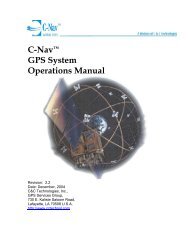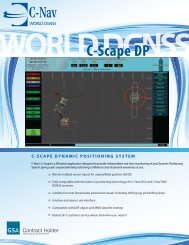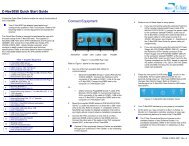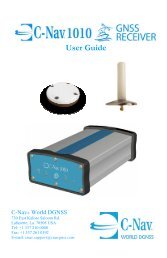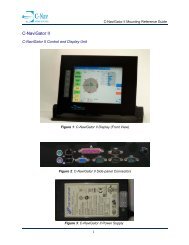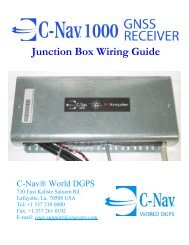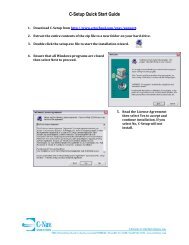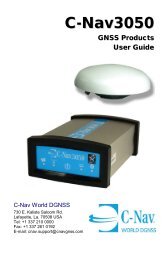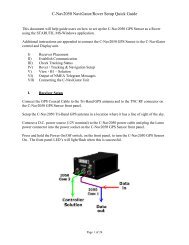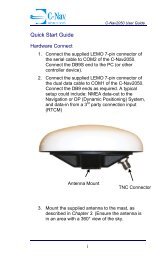Guidelines for the use of GNSS in surveying and mapping
Guidelines for the use of GNSS in surveying and mapping
Guidelines for the use of GNSS in surveying and mapping
Create successful ePaper yourself
Turn your PDF publications into a flip-book with our unique Google optimized e-Paper software.
station need not be perfect; however, when <strong>the</strong><br />
accuracy <strong>of</strong> <strong>the</strong> height component is required to be<br />
better than 40mm, site selection is more important.<br />
In this case <strong>the</strong> reliability <strong>of</strong> <strong>the</strong> results will be<br />
adversely affected by trees block<strong>in</strong>g <strong>the</strong> signals <strong>and</strong><br />
by multipath from build<strong>in</strong>gs <strong>and</strong> reflective objects. It<br />
is best practice to select sites <strong>for</strong> <strong>GNSS</strong> control<br />
observations that have a completely clear sky view<br />
above 10° elevation <strong>and</strong> no objects such as<br />
build<strong>in</strong>gs that might ca<strong>use</strong> multipath (alternatively,<br />
Virtual RINEX data can be <strong>use</strong>d, which replaces <strong>the</strong><br />
need to set up a base station if <strong>the</strong> area is with<strong>in</strong> a<br />
COGR network). In addition, <strong>the</strong> survey stations<br />
should be connected by closed loop spirit levell<strong>in</strong>g,<br />
which should be moved up or down to best fit <strong>the</strong><br />
<strong>GNSS</strong> height observations, ra<strong>the</strong>r than adjusted to<br />
fit <strong>the</strong> <strong>GNSS</strong>-observed heights.<br />
In this section, static surveys are grouped <strong>in</strong><br />
descend<strong>in</strong>g levels <strong>of</strong> precision.<br />
4.2.1 High-precision static<br />
Dual-frequency static (<strong>for</strong> l<strong>in</strong>es <strong>of</strong> less than 100km)<br />
methods are most suitable <strong>for</strong> control surveys <strong>and</strong><br />
af<strong>for</strong>d <strong>the</strong> highest precision (sub-centimetre)<br />
achievable with <strong>GNSS</strong>. It requires <strong>the</strong> simultaneous<br />
observation at two or more stations <strong>of</strong> <strong>GNSS</strong> data<br />
from four or more common satellites. Carrier phase<br />
<strong>and</strong> code measurements are made on all available<br />
frequencies. A basel<strong>in</strong>e vector is computed after<br />
<strong>the</strong> observations have been logged, us<strong>in</strong>g a<br />
differenc<strong>in</strong>g technique. This is not expla<strong>in</strong>ed <strong>in</strong><br />
detail <strong>in</strong> this document. Full details can be found<br />
with<strong>in</strong> <strong>the</strong> books listed <strong>in</strong> Appendix C.<br />
The basel<strong>in</strong>e computation is a series <strong>of</strong> process<strong>in</strong>g<br />
steps. Triple differenc<strong>in</strong>g is <strong>of</strong>ten <strong>use</strong>d, firstly to<br />
determ<strong>in</strong>e <strong>and</strong> correct cycle slips <strong>in</strong> <strong>the</strong> data. The<br />
basel<strong>in</strong>e estimation <strong>the</strong>n proceeds us<strong>in</strong>g a double<br />
difference <strong>of</strong> <strong>the</strong> phase observables. In modern<br />
process<strong>in</strong>g methods highly advanced statistical<br />
test<strong>in</strong>g is carried out to determ<strong>in</strong>e <strong>the</strong> best<br />
c<strong>and</strong>idate with<strong>in</strong> a search area, <strong>for</strong> <strong>in</strong>teger<br />
ambiguity determ<strong>in</strong>ation. A series <strong>of</strong> solutions can<br />
be determ<strong>in</strong>ed us<strong>in</strong>g comb<strong>in</strong>ations <strong>of</strong> <strong>the</strong> phase<br />
obervables such as ‘wide lane’ or ‘narrow lane’.<br />
These are <strong>of</strong>ten <strong>use</strong>d as a step to confirm<strong>in</strong>g <strong>the</strong><br />
f<strong>in</strong>al solution, which is ei<strong>the</strong>r ‘iono free fixed’ or ‘L1<br />
fixed’, accord<strong>in</strong>g to basel<strong>in</strong>e length.<br />
A successful outcome from each <strong>of</strong> <strong>the</strong>se<br />
process<strong>in</strong>g steps is most likely when:<br />
+ <strong>the</strong>re is a large amount <strong>of</strong> good quality data<br />
+ <strong>the</strong> antennas rema<strong>in</strong> stationary dur<strong>in</strong>g <strong>the</strong><br />
observations<br />
+ <strong>the</strong>re is a significant geometry change <strong>in</strong> <strong>the</strong><br />
satellite constellation.<br />
As <strong>the</strong>se conditions all exist <strong>in</strong> <strong>the</strong> high-precision<br />
static method, <strong>the</strong> best results are achieved. The<br />
high volume <strong>of</strong> data is <strong>use</strong>d to not only solve <strong>for</strong><br />
<strong>the</strong> <strong>in</strong>teger ambiguity as mentioned above, but also<br />
to solve <strong>for</strong> o<strong>the</strong>r unknowns <strong>in</strong> <strong>the</strong> ma<strong>the</strong>matical<br />
process <strong>of</strong> comput<strong>in</strong>g <strong>the</strong> basel<strong>in</strong>e.<br />
In addition, o<strong>the</strong>r errors such as <strong>the</strong> delays ca<strong>use</strong>d<br />
by <strong>the</strong> atmospheric refraction can be solved by <strong>the</strong><br />
s<strong>of</strong>tware. In essence, high-precision surveys require<br />
<strong>the</strong> removal <strong>of</strong> as many system errors as possible.<br />
This <strong>in</strong>cludes <strong>the</strong> <strong>use</strong> <strong>of</strong> <strong>the</strong> precise ephemeris, as<br />
it removes <strong>the</strong> orbital errors which are present <strong>in</strong><br />
<strong>the</strong> broadcast ephemeris. The actual ephemeris is<br />
available <strong>in</strong> several <strong>for</strong>ms (rapid, ultra-rapid,<br />
precise) from various sites on <strong>the</strong> <strong>in</strong>ternet <strong>and</strong> is<br />
generated from earth track<strong>in</strong>g stations which<br />
precisely measure <strong>the</strong> satellite positions. It is<br />
usually available <strong>for</strong> download a few days after <strong>the</strong><br />
survey data has been logged. It is important to<br />
ensure that <strong>the</strong> make <strong>of</strong> <strong>the</strong> process<strong>in</strong>g s<strong>of</strong>tware<br />
<strong>and</strong> <strong>the</strong> version be<strong>in</strong>g <strong>use</strong>d is capable <strong>of</strong> import<strong>in</strong>g<br />
a precise ephemeris <strong>and</strong> us<strong>in</strong>g it correctly. When<br />
comput<strong>in</strong>g basel<strong>in</strong>es <strong>of</strong> longer than about 80km,<br />
‘scientific’ s<strong>of</strong>tware which <strong>in</strong>corporates algorithms<br />
to compute ocean tide load<strong>in</strong>g <strong>and</strong> tropospheric<br />
errors should be <strong>use</strong>d.<br />
Epoch sett<strong>in</strong>gs or ‘epoch <strong>in</strong>tervals’ are <strong>the</strong> rate at<br />
which data is logged <strong>in</strong> <strong>the</strong> memory <strong>of</strong> <strong>the</strong> receiver.<br />
In <strong>the</strong> differenc<strong>in</strong>g process, to compute <strong>the</strong><br />
basel<strong>in</strong>e solution <strong>the</strong> observations from one epoch<br />
are differenced with those from <strong>the</strong> next. The<br />
<strong>in</strong>terval appropriate <strong>for</strong> any particular survey<br />
depends on a variety <strong>of</strong> factors. These <strong>in</strong>clude <strong>the</strong><br />
type <strong>of</strong> basel<strong>in</strong>e process<strong>in</strong>g s<strong>of</strong>tware, <strong>the</strong> amount <strong>of</strong><br />
memory available <strong>in</strong> <strong>the</strong> receiver, <strong>and</strong> <strong>the</strong> density <strong>of</strong><br />
po<strong>in</strong>t data needed <strong>for</strong> <strong>the</strong> survey. In a static survey,<br />
as <strong>the</strong> antennas rema<strong>in</strong> fixed, <strong>the</strong>re is no need <strong>for</strong><br />
an epoch sett<strong>in</strong>g <strong>of</strong> less than 15 seconds. In some<br />
cases, when long basel<strong>in</strong>es are <strong>in</strong>volved <strong>and</strong> noisy<br />
atmospheric conditions exist, it is best to reduce<br />
<strong>the</strong> epoch sett<strong>in</strong>gs still fur<strong>the</strong>r, to 20 or 30 seconds.<br />
Whatever epoch sett<strong>in</strong>g is selected, it is imperative<br />
that all receivers <strong>use</strong>d <strong>in</strong> <strong>the</strong> survey are set to <strong>the</strong><br />
same <strong>in</strong>terval.<br />
GUIDELINES FOR THE USE OF <strong>GNSS</strong> IN LAND SURVEYING AND MAPPING |31





